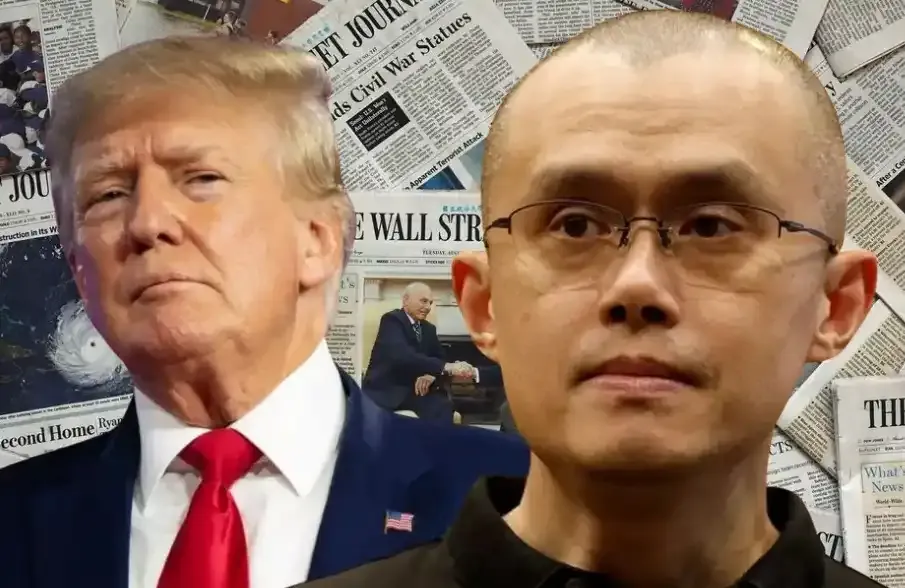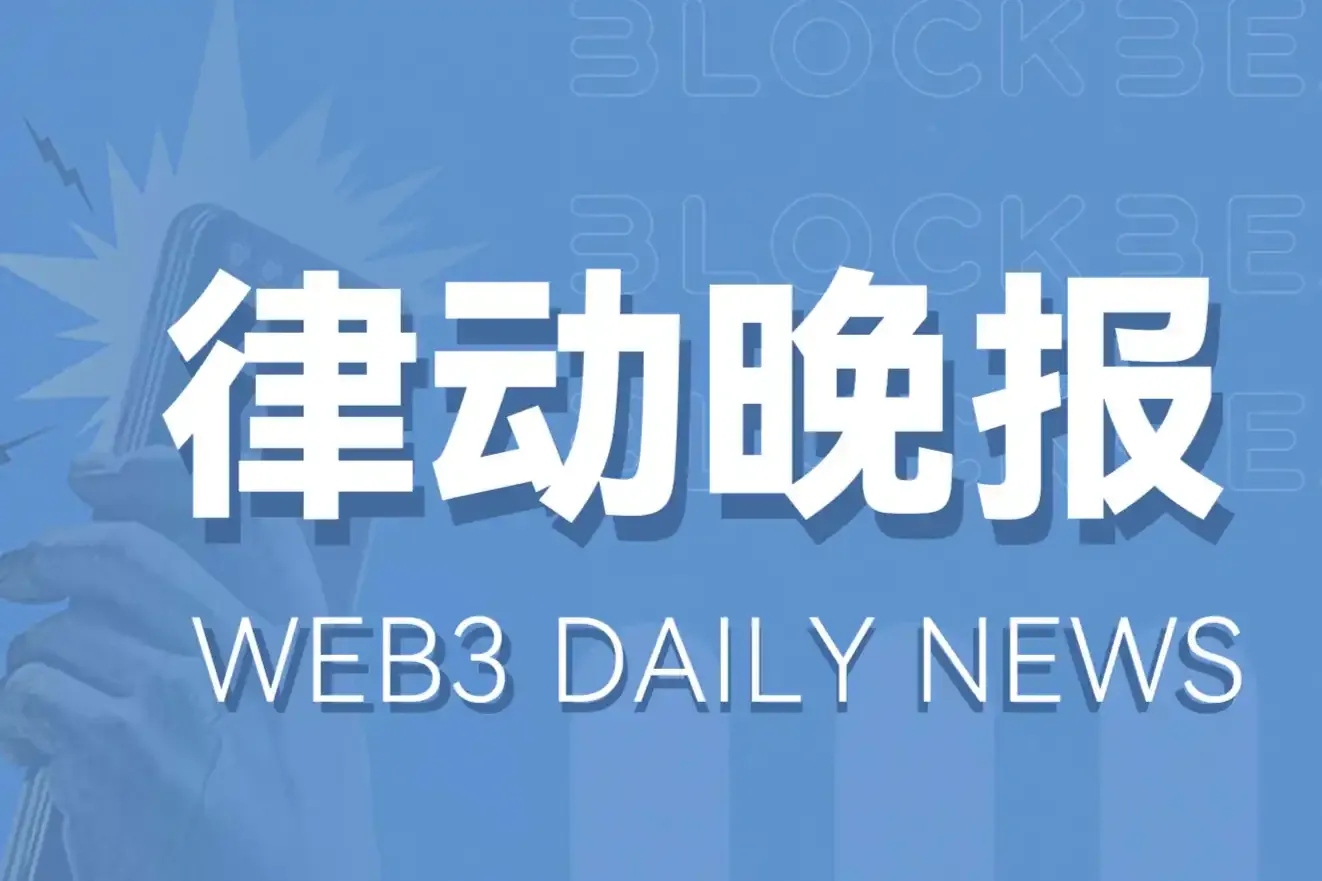Written by: Tuo Luo Finance
Predictive markets are becoming the new darling of Wall Street.
This month, the parent company of the New York Stock Exchange, Intercontinental Exchange (ICE), invested $2 billion in the decentralized predictive market Polymarket. This is not only one of the largest private fundraising efforts in crypto history but also skyrocketed Polymarket's valuation to $9 billion. Recently, there have been reports that Polymarket is in early discussions with investors and is seeking to raise funds at a valuation between $12 billion and $15 billion.
Interestingly, just four months ago, Polymarket's valuation was less than one-tenth of what it is today. If we rewind to 2022, Polymarket was even once pursued by regulators.
The surge in Polymarket's valuation is astonishing, and predictive markets are once again in the spotlight.
When mentioning Polymarket, the first association that comes to mind is predictive markets. What are predictive markets? Despite the fancy terminology, the essence of predictive markets is simply probability betting, or more straightforwardly, a variant of gambling. Of course, this method is not the same as pure speculation; the bets themselves rely on information mastery and probability forecasting, which can be more aptly described as an "information war." Using prices to buy probabilities is clearly the most objective medium reflecting the direction of information.
Historically, the earliest predictive markets can be traced back to the 16th century when various gambling establishments were set up in Rome, Italy, around the election of the Pope. By the 18th century, the scope of betting expanded, evolving from single issues to "everything can be bet on." In the 19th century, the global political hotspot of U.S. elections ignited the passion for predictive markets, leading to their gradual prosperity. However, as the methodology of prediction based on "statistics" improved, the "irrational" characteristics of predictive markets caused them to take a backseat. Nevertheless, the spark of predictive markets did not extinguish; the non-profit experimental project Iowa Electronic Markets, operated by the University of Iowa, successfully demonstrated the potential of predictive markets during the 1988 presidential election, becoming one of the earliest and most famous predictive markets. Subsequently, Hollywood Stock Exchange, Policy Analysis Market, Intrade, and PredictIt emerged, and predictive markets evolved from centralized to decentralized, ultimately shaping the current landscape of predictive markets.
Polymarket is a representative of decentralized predictive markets. It is worth mentioning that Polymarket is not the first decentralized predictive market application; as early as 2018, a decentralized predictive product called Augur appeared on Ethereum. However, its development fell into the traditional crypto trap, relying on platform tokens for betting and focusing on the completion of smart contracts rather than user experience, ultimately leading to its failure.
Polymarket learned from the lessons of its predecessors and places great emphasis on user experience, both in terms of mechanism and interface. Initially built on Ethereum smart contracts, Polymarket later migrated to the more scalable sidechain Polygon. Users can participate simply through a wallet without identity verification, and the only supported betting currency is USDC, ensuring stable chips.
From an architectural perspective, Polymarket employs the Conditional Token Framework (CTF) developed by Gnosis, allowing users to bet on specific outcomes by purchasing conditional tokens and introducing a bundling concept for easier purchasing. The market direction relies on a central limit order book, commonly used in traditional financial markets, to create a hybrid structure of off-chain matching and on-chain settlement, ensuring a smooth user experience.
It sounds quite complex, but from the user's perspective, it is very simple. Users place bets using stablecoins, with questions corresponding to the market, offering only binary options of "yes" or "no." A correct prediction earns $1, while an incorrect one earns nothing. Under the CTF framework, the price represents the probability of the event occurring. For example, if the bet is $0.69, it indicates a 69% probability of the event happening.
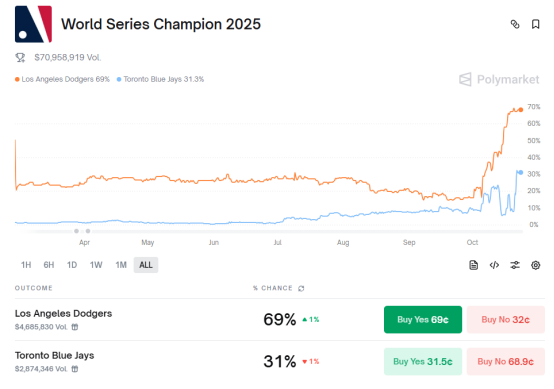
From infrastructure setup to smart contract operation, it is clear that Polymarket is a purely decentralized application. In this predictive market, the platform is not a counterparty, and there is no need to worry about the house taking a cut, nor is there large-scale public opinion manipulation or information bombardment. In fact, no one knows who you are; you simply place bets based on your personal will.
With these advantages, Polymarket, founded in 2020, quickly experienced explosive growth. In 2023, its trading volume exceeded $1 billion, and in 2024, it gained attention for successfully predicting the U.S. elections, with total trading volume soaring to $8.6 billion, making it one of the leading applications in predictive markets. Just in the first half of this year, Polymarket's trading volume reached $6 billion, and the cumulative total trading volume has exceeded $20 billion to date.
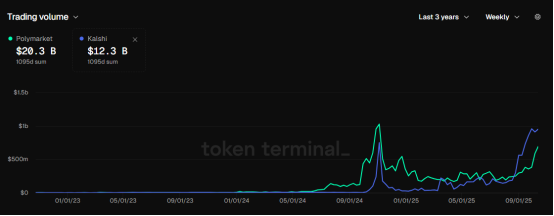
Despite the seemingly smooth development path, it has not been without its challenges. From a regulatory perspective, Polymarket's mechanism is difficult to define; it can be seen as gambling, but it can also be considered a binary options swap. This is because, unlike traditional gambling, contracts on Polymarket can be traded before the event concludes. For example, if a user buys a contract for "Trump winning the election" at $0.1, and later the contract rises to $0.4, the user can sell the contract for a profit, even if the event has not yet concluded. This mechanism has clear advantages and disadvantages. The advantage is that it truly transforms predictive markets from focusing on outcomes to the trading process, allowing bets to dynamically change based on real-world contexts, creating opportunities for volatility arbitrage and making betting more flexible. However, it inevitably turns betting contracts into a type of investable financial derivative.
In this context, in 2022, Polymarket was accused by the U.S. CFTC of operating an unregistered exchange providing illegal trading. Ultimately, Polymarket reached a settlement with regulators, agreeing to pay a $1.4 million fine and exit the U.S. market. In 2024, after Trump emerged as a significant figure in the betting market for election predictions, Polymarket faced severe crackdowns from U.S. authorities. In November, the FBI raided CEO Shayne Coplan's residence, seizing his electronic devices, and investigations by the U.S. Department of Justice and CFTC followed, hinting at a political purge.
Of course, after Trump took office, the overall environment changed rapidly. Almost all of Biden's enemies were treated with courtesy by Trump. In July of this year, the U.S. Department of Justice and CFTC halted their investigation into Polymarket. Shortly thereafter, Polymarket announced it had acquired QCX LLC and its affiliated clearinghouse QC Clearing LLC for $112 million. This is a small derivatives exchange holding a CFTC license. Polymarket's strategy became clear, intending to re-enter the U.S. market through acquisition. In September of this year, QCX received a no-action letter from the CFTC, officially clearing the main obstacle for Polymarket's return to the U.S. market.
With the compliance puzzle solved, investors flocked in. In January, Polymarket completed a $150 million financing round led by Founders Fund and Dragonfly, achieving a valuation of $1.2 billion. In October, Polymarket secured $2 billion in financing from ICE, raising its valuation to $9 billion. Recently, there have been rumors that Polymarket is set to raise funds at a valuation of $12 billion. Interestingly, Donald Trump's venture capital fund, 1789 Capital, is also on its shareholder list, indirectly proving Polymarket's legitimacy.
Now, Polymarket has risen to become a major player in the crypto market, with weekly trading volumes reaching an astonishing $1 billion. When discussing predictive markets, Polymarket is undoubtedly an unavoidable topic. For users, how the platform operates is less important; personal profit is the core concern. It is worth noting that Polymarket's CEO has hinted at the possibility of issuing tokens, which has generated significant market anticipation. However, based on the current investments, going public may align better with its market positioning.
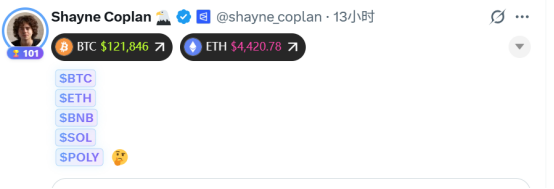
On the other hand, while the future looks bright, Polymarket also has its underlying issues. One is that there are vulnerabilities in the technical mechanism. Polymarket uses the UMA protocol as a decentralized oracle solution, responsible for reliably writing the results of real-world events onto the blockchain, relying on UMA oracles to determine outcomes. However, decentralized oracles do not always guarantee correct answers. The general process for oracle determination is that after an event occurs, if there are no disputes, the result is directly published; if there are disputes, it enters a voting period where users holding UMA tokens can vote on the dispute, with the final result being authoritative. This seemingly fair solution has a fatal flaw: in such situations, large holders of UMA tokens wield significant influence and can even "fabricate the truth." In March of this year, regarding the event "Will Ukraine reach a rare earth trading agreement with Trump before April?" the real outcome was "no," but the oracle ultimately determined "yes," because large holders manipulated the oracle to change the result. Furthermore, even excluding oracle issues, the subjectivity of decentralized voting can affect actual judgments, leading to disputes in ambiguous situations due to a lack of fair assessment.
The second issue is regulatory uncertainty. Although the current U.S. government has significantly loosened regulations on the crypto market, gambling regulations have not been fully lifted. The issues of market manipulation and insider trading inherent in Polymarket remain unresolved, leaving regulatory ambiguities.
After the issues arise, market challenges follow closely behind. In the predictive market, Polymarket and Kalshi present a competitive landscape. In terms of differentiation, the former offers a more native experience, emphasizing decentralization and covering a broader range of prediction fields, including politics, economics, sports, and entertainment. In contrast, the latter leverages compliance as its competitive edge, being a regulated exchange approved by the U.S. CFTC, making it more attractive to institutional users and outsiders. Although Polymarket currently leads with a significant advantage in trading volume and brand recognition, Kalshi is clearly gaining momentum. Kalshi's market share, calculated based on nominal trading volume through the Dune platform, rose from 8% in January 2025 to 66% in September 2025. Although it has since dropped to 46.6%, the growth momentum remains strong. Even in recent financing, Kalshi is not falling behind, with reports that it is receiving financing offers from venture capital firms, with a valuation range of $10 billion to $12 billion.
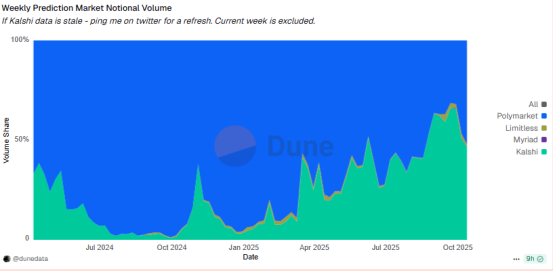
The competition is becoming increasingly fierce, but the heavy capital investment also indicates that predictive markets are rapidly rising with sweeping momentum. Whether it is Polymarket or Kalshi, they are merely one of the betting targets within this larger context. The importance of predictive markets lies in the information pricing behind them. Probability reflects information, and information is manifested through price; this pricing decision-making approach truly shifts decision-making from "timely response" to "information forecasting."
This can be likened to traditional media, which is highly valued in the financial sector due to its information transmission nature and the potential market reactions it can generate. However, as media aligns more closely with financial and political groups, it drifts away from its original impartiality and independence, beginning to convey certain biases, and is even controlled by a minority of elites. The emergence of predictive markets serves as a good supplement. Betting with prices reflects internal sentiments and signals more accurately and distinctly, and the feedback from price fluctuations is more real-time. In other words, predictive markets are becoming a new type of information medium. This medium releases the information pricing power, originally confined to elitism, to the public, achieving timely feedback on event-driven data amidst volatility. This not only represents simple betting predictions but also signifies a paradigm shift in the deeper price discovery system, the value of which is self-evident.
For example, events that some media may not consider important or have overlooked could receive significant attention in predictive markets. This attention is the root of price, and for publicly listed companies, it is more valuable than annual financial reports and marketing advertisements. This may also be one of the reasons why the New York Stock Exchange invested in Polymarket, supplementing the pricing of expectations and attention into the traditional asset pricing system, reflecting an alignment with objective trends. It is reported that ICE has obtained global distribution rights for Polymarket's event-driven data through this investment and plans to apply it to next-generation tokenization projects.
While the prospects are promising, ethical issues are not absent. The ability to bet on everything also implies the financialization of all things, and in a certain sense, the entertainment of everything. However, there will always be events that cannot be trivialized. When two collisions occur, what future will predictive markets face?
Of course, it is still too early to discuss this; before that, predictive markets have a long way to go.
免责声明:本文章仅代表作者个人观点,不代表本平台的立场和观点。本文章仅供信息分享,不构成对任何人的任何投资建议。用户与作者之间的任何争议,与本平台无关。如网页中刊载的文章或图片涉及侵权,请提供相关的权利证明和身份证明发送邮件到support@aicoin.com,本平台相关工作人员将会进行核查。


